Restoring the Crum Woods
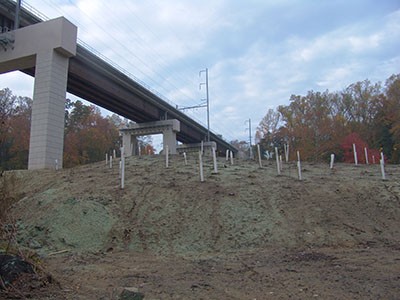 The complication of the SEPTA Viaduct brings to a close a five-year period of construction in the Crum Woods. Seventeen acres of upland forest and wetland were clear-cut for the SEPTA Viaduct construction. Nine different plant communities are part of the restoration plan ranging from lowland meadow to a red oak mixed hardwood forest.
The complication of the SEPTA Viaduct brings to a close a five-year period of construction in the Crum Woods. Seventeen acres of upland forest and wetland were clear-cut for the SEPTA Viaduct construction. Nine different plant communities are part of the restoration plan ranging from lowland meadow to a red oak mixed hardwood forest.
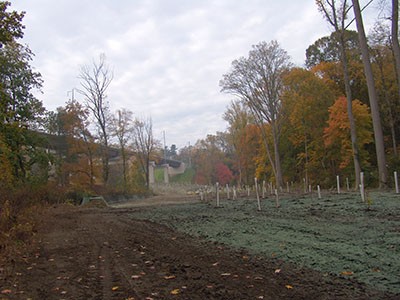
At 2.55 acres, the tulip tree-beech-maple forest planting is the largest restoration community with woody plants in the mix. photo credit: R. Robert
At 2.55 acres, the tulip tree-beech-maple forest planting is the largest restoration community with woody plants in the mix. As the name implies, this community consists predominantly of Acer rubrum, Fagus grandifolia, and Liriodendron tulipifera. The understory shrubs consist of Hamamelis virginiana (witch hazel), Amelanchier canadensis (serviceberry), and Crataegus crus-galli (cockspur hawthorn).
A tulip tree-beech-maple forest typically occurs in fairly, deep but not strongly acidic soil at a mid to lower slope position. If not over browsed, this community supports a diverse herbaceous layer with plants including spring ephemerals such as common jack-in-the-pulpit, mayapple, yellow trout lily, large-flowered trillium, and wild ginger.
This diversity also supports a variety of wildlife: short-tailed shrew, white-footed mouse, long-tailed weasel, and eastern chipmunk. One can also find red-backed salamander, gray treefrog, American toad, black rat snake, and spicebush swallowtail butterfly. Nesting habitat for many forest birds such as wood thrush, scarlet tanager, rose-breasted grosbeak, red-eyed vireo, ovenbird, hooded warbler, American redstart, cerulean warbler, barred owl, and pileated woodpecker can found in this forest community.
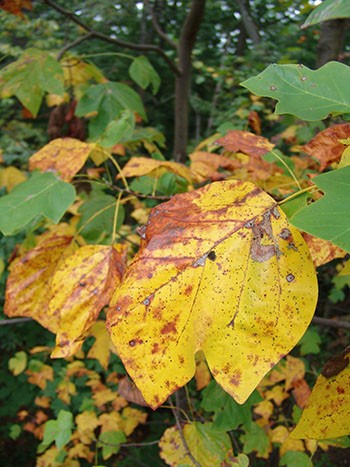
The yellow color of Liriodendron tulipifera adds fabulous autumn splendor in the space this time of year. photo credit: R. Robert
The Arboretum uses these native canopies – tulip trees, beeches, and red maples – through the campus as great garden plants too. Tulip trees, Liriodendron tulipifera, tower over the Scott Outdoor Amphitheater. Its stick-straight habit makes it ideal for creating a tall canopy with dappled shade for visitors and nesting habitat for birds. The yellow color adds fabulous autumn splendor in the space this time of year. The spring flowers attracts butterflies and hummingbirds.
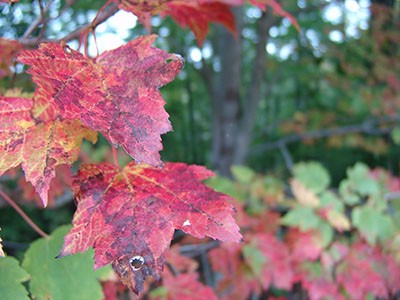
One of the most commonplace native trees, red maple do not disappoint when it comes to fall color. photo credit: R. Robert
Red maples, Acer rubrum, are great deciduous trees for your garden. One of the most commonplace native trees, red maple do not disappoint when it comes to fall color. On campus we have several striking cultivars including A.rubrum ‘Brandywine’ and A. rubrum ‘Red Sunset’, both selected for their brilliant fall color. This canopy also provide cover for screech owls and pileated woodpeckers while common flickers nest in the cavities.
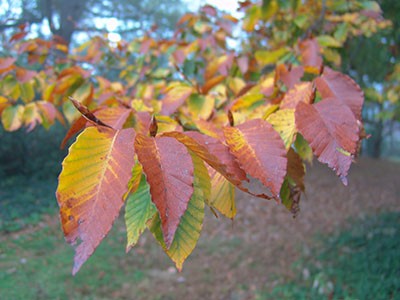
The dark green toothed leaves of Fagus grandifolia brighten to a golden bronze in the fall. photo credit: R. Robert
Finally the American beech tree, Fagus grandifolia, is a large deciduous tree known for its smooth, grey bark. These specimen trees have a dramatic presence in the landscape with low branching and mature trunks of 2- to 3- feet in diameter. The dark green toothed leaves brighten to a golden bronze in the fall. The beech nut, which ripens in the fall, is a great food source for birds and mammals like mice, squirrels,chipmunks, black bear, deer, foxes, ruffed grouse, ducks, and bluejays.
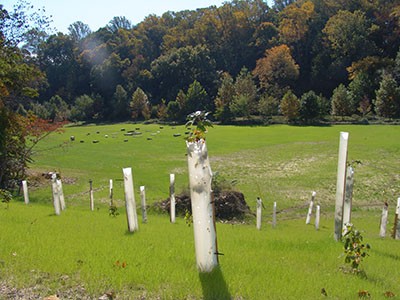
I invite you to visit the newly open area around the SEPTA Viaduct to see the restoration and watch it mature. photo credit: R. Robert
I invite you to visit the newly open area around the SEPTA Viaduct to see the restoration and watch it mature. I also invite to you find the young plants we have planted and compare them to the matures ones that have been gracing the campus for generations. Consider planting native trees in your own garden to help ecosystem as a whole.
____________________________________________________________________________________________________________________________
This article is part of an ongoing column called the Crum Woods Chronicle. The Crum Woods Chronicle will be periodic updates and observations about subjects related to natural history, interesting species found in and around the Crum Woods, and exciting events you can get involved in. My hope is that some of these topics will interest you, strengthen your connection to the Crum Woods, and inspire you to explore your backyard a little more often.
Natural areas do not maintain their character and quality independently, especially when they are heavily used by people and embedded in urban environments. Educating yourself about aspects of the Crum Woods that interest you and understanding how your individual use of the Crum Woods impacts it (and how you can reduce that impact!) are important steps every one of us should take.
“In the end we will conserve only what we love; we will love only what we understand; and we will understand only what we are taught.” –Baba Dioum





No Comments